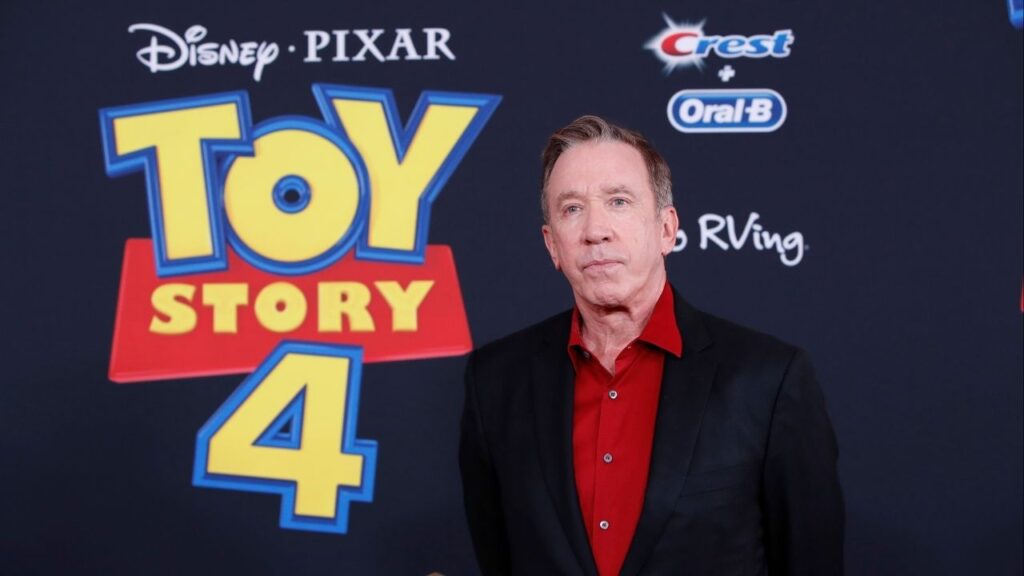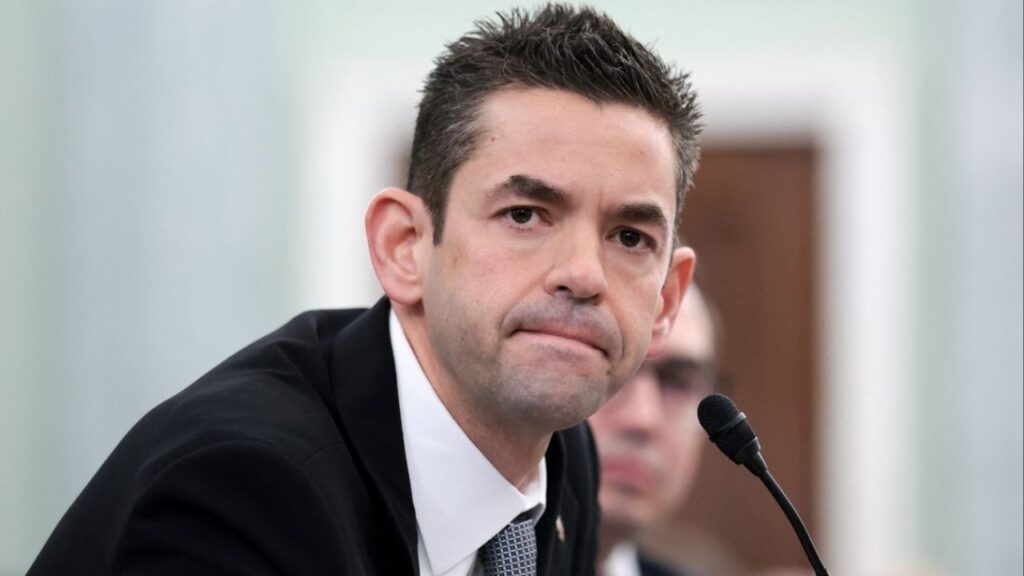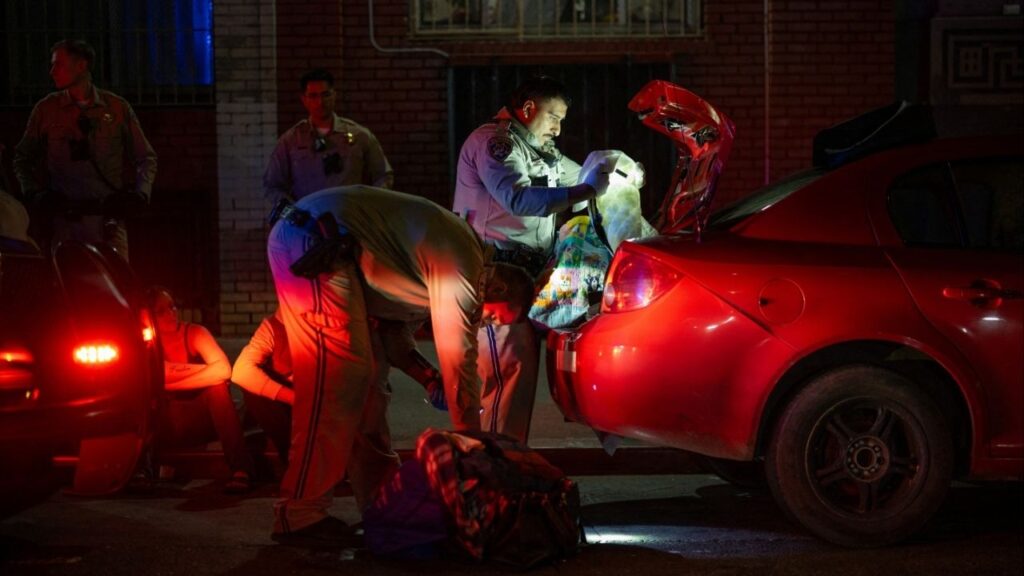A graphic of Vice President Kamala Harris is shown at her rally in Greenville, N.C. on Sunday, Oct. 13, 2024. Future Forward, a super PAC supporting the Harris campaign, has raised a staggering $700 million in combination with an affiliated nonprofit group. (Erin Schaff/The New York Times)

- Future Forward, a major Democratic super PAC, has raised $700 million and focuses heavily on data-driven political advertising.
- The group’s strategy emphasizes late-stage ad spending, testing thousands of messages to identify the most effective ones.
- Some Democrats worry about over-reliance on Future Forward's approach, fearing it neglects direct voter outreach and tailored messaging.
Share
|
Getting your Trinity Audio player ready...
|
The biggest super political action committee in American politics is in the middle of an unparalleled spending spree, unleashing more money on television advertising in the closing weeks of the 2024 race than the campaigns of Donald Trump and Kamala Harris combined.
The group, known as Future Forward, has ascended to the pinnacle of the Democratic political universe with remarkable speed, winning over some of the world’s richest people with grand promises of a “Moneyball” method to political advertising that it has pitched as the most sophisticated ever undertaken.
The group is, in some ways, an ad-making laboratory masquerading as a super PAC, testing thousands of messages, social media posts and ads in the 2024 race, ranking them in order of effectiveness and approving only those that resonate with voters. Ad-makers produce about 20 potential commercials for every spot that ever airs. And Future Forward has conducted nearly 4 million voter surveys since Harris entered the race — and more than 10 million since January.
“They’re probably the most analytics- and evidence-driven PAC I’ve ever seen,” said David Nickerson, a political scientist who ran the experiments division of Barack Obama’s 2012 presidential campaign.
Related Story: Harris Agrees Trump Is a Fascist: 5 Charlamagne Interview Takeaways
Publicly, Harris and Democratic leaders are appreciative of the group’s work. But Future Forward’s insular approach to spending the staggering $700 million it has raised in combination with its affiliated nonprofit group has led to suspicion and second-guessing, including inside Harris’ headquarters.
The story of Future Forward’s rise and its central if mostly hidden role in 2024 is based on interviews with more than four dozen Democratic strategists, donors and aides to Harris and the group, many of whom insisted on anonymity to share closely held information. The New York Times also reviewed internal Future Forward records and donor presentations.
Founded by a group of wonkish Obama campaign veterans, Future Forward is animated by the idea that a blend of data science, political science and testing can usher in a new era of rigor in advertising. The group’s ads were widely praised in 2020, and Future Forward earned the coveted designation as the official super PAC first for President Joe Biden and then for Harris.
But throughout the year, some top party strategists have worried about the consolidation of so much money and decision-making in a single group. They warn of succumbing to what some describe as a tyranny of testing and about what they see as an almost dogmatic belief by Future Forward in the power of late advertising — to the detriment of other methods of reaching voters.
In September, the Harris campaign made an unusual public statement suggesting donors back other groups devoted to get-out-the-vote operations.
Soon after, Billy Wimsatt, who runs a donor group called the Movement Voter Project, warned in a memo to Democratic donors, Future Forward and the Harris campaign last month that get-out-the-vote operations were “dangerously underfunded” — to the tune of $165 million, mostly affecting groups that turn out Black, Latino, Asian and young voters.
“It seems like a ton of money is going to paid media and not enough to the ground game,” Wimsatt warned. More recently, the Harris headquarters has been frustrated by a lack of mailers being sent by allies.
Future Forward’s belief in designing digital and television advertising to appeal to the general population — “gen pop” ads, in industry shorthand — has also worried strategists who want more messages tailored to people of color. Future Forward says its ads are placed on platforms watched disproportionately by minority audiences, and the group is on pace to spend $30 million on Spanish-language television. Still, Future Forward officials have advised Democrats that more broadly focused ads often prove most effective, and the group’s roughly $450 million in advertising decisions reflects that belief.
It’s a big bet, and the sheer volume of spending means that Future Forward will receive at least some credit if Harris wins — and blame if she loses.
Related Story: Trump, Harris Locked in Tie as Election Day Nears, NBC News Poll Shows
655 Harris Ads
A trove of Future Forward’s ad-testing results, obtained by the Times, shows the remarkable level of detail in the ways the group studies what is on the airwaves.
Since July, the group has ranked the effectiveness of more than 300 ads that were run online and on television on behalf of both candidates — down to a tenth of a percentage point of precision in multiple categories.
The results show the top-testing Harris ad through the end of September was a 60-second spot of her delivering a speech about her most popular economic proposals. The most effective Trump campaign television ad featured Harris dancing and called her the “border czar” while denouncing her as “failed, weak, dangerously liberal.”
Future Forward compiles its findings in closely read emails called “Doppler” and “Flight Radar.” One recent message warned of the need to focus on how Harris’ specific policy proposals would tangibly affect voters’ lives, rather than engaging in lofty rhetoric. “When we go high, effects go low,” it said.
The group has also shared broad thematic findings with allies, including that purely negative ads against Trump barely make a difference.
In Harris’ first months as the Democratic nominee, Future Forward has commissioned 655 potential ads from 25 ad-makers at a cost of $6.6 million. The biggest paydays go to those firms whose ads actually run — so far, slightly more than half. Privately, some ad-makers compare the opaque process to a “Hunger Games” competition.
Future Forward uses online surveys to measure which potential ads will move voters most. It’s a laborious process, but officials say the ads that emerge are on average 35% more effective than those they reject.
Much of the testing is run through an independent firm incubated by Future Forward called Blue Rose Research, whose scoring regimen some Democrats fear has too much agenda-setting power, in part because of Future Forward’s strong recommendation. “If we’re right, we’re all right,” said one person involved in the effort, granted anonymity to candidly discuss the group’s influence in Democratic politics. “If we’re wrong, we’re all wrong.”
Ishanee Parikh, Future Forward’s creative director, said in a rare public statement that the process led to the “most effective ads.”
“We use multiple tests, focus groups and polling to understand what works, produce hundreds of spots with dozens of firms, and air the ads we know are most persuasive,” she said.
Related Story: Kamala Harris Will Sit Down With Bret Baier for Her First Fox News Interview
A Super PAC From Nowhere
When Future Forward first began reserving huge volumes of television airtime four years ago, Biden’s presidential campaign team was alarmed. “We were concerned they were a new pro-Trump super PAC,” recalled Anita Dunn, a senior Biden adviser at the time.
It turned out to be just the opposite.
A collection of Democratic megadonors, mostly from Silicon Valley, had plotted with a handful of number-crunching strategists to surprise Biden’s team with more than $100 million in supportive ads.
Leading the group was Chauncey McLean, who sits at the center of a close-knit network of Ph.D.s who have ascended in the party by displaying encyclopedic knowledge of randomized-controlled trials and political science literature more than working the Washington cocktail circuit.
Two other members of this political clique are Future Forward’s co-founders Gaurav Shirole and Jon Fromowitz. Shirole formed a survey firm named for their first initials, GCJ Research, which conducted so many surveys for the super PAC that people have posted on Reddit asking whether it’s a scam.
Related Story: Harris Agrees Trump Is a Fascist: 5 Charlamagne Interview Takeaways
McLean, who lives in Seattle, can be elusive. One strategist who talked to McLean several times a week for a year said he had never met him in person. Several donors and elected officials who munched on Giordano’s pizza and mini Chicago hot dogs at Future Forward’s luxury suite during the Democratic convention had to be reminded exactly who McLean was by Katie Petrelius, a senior Future Forward adviser and former top Biden fundraiser. Facebook co-founder Dustin Moskovitz has given Future Forward more than $50 million since 2020, but has never spoken to McLean, according to two people familiar with the relationship.
The group prizes secrecy, conducting much business on the encrypted app Signal and keeping information siloed even from people and groups it works with. The super PAC has shielded from disclosure the source of over $130 million in contributions, nearly 40% of what it has raised. It has done so by receiving money in a secret-money nonprofit arm and then transferring those undisclosed donations to the super PAC.
Some past super PAC leaders have become national figures. McLean, however, has made only a single public appearance this entire election cycle. He declined to comment for this article.
All that discretion appealed to the Biden team. Four years after scrambling to find out about Future Forward, Dunn helped broker its selection as Biden’s super PAC — and now works for it.
Mistrust Among Democrats
Future Forward’s advertising strategy can be summed up in four words: Reserve early, spend late.
The group began booking fall ads in January to secure the best prices. The most intense spending is occurring now, guided by an unswerving belief that the persuasive effect of ads decays quickly.
The strategy sounds simple enough. In practice it meant sitting on the sidelines over the summer as Biden was drowning politically after his disastrous debate with Trump. McLean told donors that Biden faced a problem advertising could not solve.
Mistrust spread when polling leaked from firms with deep ties to Future Forward that showed how damaging the debate had been to Biden — twice. The first survey explicitly tested possible alternatives to Biden as the nominee. Then, days before Biden dropped out, another report circulated on Capitol Hill detailing the woeful state of the Biden campaign.
Related Story: Trump, Harris Locked in Tie as Election Day Nears, NBC News Poll Shows
But the most intense friction between Democratic groups and Future Forward has concerned issues of race.
Future Forward opened October spending $35 million to broadcast a single advertisement that juxtaposes Trump telling his “rich as hell” supporters that he will cut their taxes with a Black voter supporting Harris because he is “not rich as hell.”
The idea is to target everyone at once, and Future Forward found in testing that the spot was in the 95th percentile for effectiveness with white, Black, Asian and Hispanic voters — as well as the electorate overall.
But the approach has skeptics among party strategists who believe Harris needs to specifically mobilize key Democratic constituencies in other ways.
“I think they’ve had too narrow a vision for how we’re going to win this election,” said Quentin James, who leads Collective PAC, a group aimed at building Black political power that has recently received a small donation from Future Forward.
Related Story: Kamala Harris Will Sit Down With Bret Baier for Her First Fox News Interview
Black senior campaign officials have fielded complaints from Black groups that Future Forward is not moving money quickly enough to them. Future Forward’s defenders say the group has been improving its approach.
Greg Speed, who runs the progressive group America Votes, which has received tens of millions of dollars for field programs from Future Forward since this summer, said “there has been a broadening of their strategic aperture as we’ve gotten into the final weeks here.”
This month, Harris’ sister, Maya Harris, appeared on a Zoom call for 100 of Future Forward’s donors and did not wade into the simmering complaints about the group.
“For them,” she said, “it’s all about impact.”
–
This article originally appeared in The New York Times.
By Theodore Schleifer and Shane Goldmacher/Erin Schaff
c. 2024 The New York Times Company
RELATED TOPICS:
Categories

Comedy Legend Tim Allen Announces Fresno Show

















